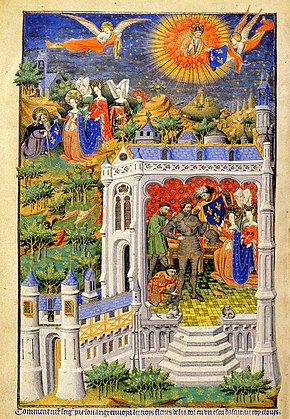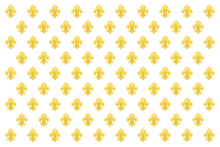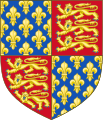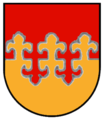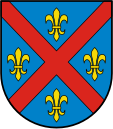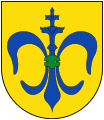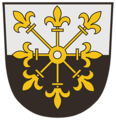Lily (heraldry)
The heraldic lily is a common figure in heraldry , consisting of three stylized leaves that are held together by a ribbon. The middle leaf is pointed above and below, the outer leaves hang down and are bent outwards at the top. The sign is a stylized iris (Iris), with the lily is related (Lilium) botanical remotely.
The Unicode symbol of the heraldic lily is U + 269C (9884) ⚜.
basic forms
The heraldic lily is called girded with the “ribbon” usually shown around the petals ; if it is missing, it is not girded . Other variants of the heraldic lily have been given separate names. If the lily lacks the middle leaf, it is emblazoned as mutilated ; the same term is used when only the lower part of the center sheet is missing. The middle leaf is often replaced by other symbols such as a cross or a stalked flower and must be described. If the outer leaves are missing below the belt, it is an Arab lily .
Color symbolism
The lily is usually gold or silver tinged .
To this day, the yellow swamp iris ( Iris pseudacorus ) is considered to be knightly , while the blue-purple cultural form of the "knight iris" ( German iris , Iris × germanica ) is shown less often in coats of arms. The white to bluish "Dalmatian Iris" ( pale iris , Iris pallida ), which, like the albino form of the " Florentine iris " ( Iris germanica var. Florentina ), is used as violet iris , violet arum or violwurtz to make violet perfume (ancient deodorant ) serves as an emblem of prosperity and wealth through trade . These lilies are shown in red, rarely black. In the following text, “lily” always means the “heraldic lily”, which from a botanical point of view is not a lily, but an iris.
Variations
Fleur-de-Lys
In French heraldry, the lily is known under the name Fleur-de-Lys or Fleur-de-Lis ("lily flower, lily flower, French lily ") and is particularly related to France as the most famous symbol of the French monarchy .
According to the legend that emerged in the high Middle Ages , the lily was presented to the Merovingian king Clovis I by an angel who came down from heaven. The story has been handed down in different variations; it was usually associated with the baptism of the Franconian ruler after the battle of Zülpich (496). Queen Chrodechild was also allowed to receive the lilies in order to have them present them to her husband, thus emphasizing their outstanding influence on the conversion of Clovis to the Catholic faith (see the illustration in the Bedford master's book of hours ; on the motif see also the Annunciation of the Lord ). In the self- image of the Capetian kingship of the high Middle Ages, the lily, as an unmistakable external symbol, supported its claim to have received royal authority directly from God without the need for mediation from the Pope or the Emperor .
In a seal of Robert II the Pious (996-1031) the lily was used for the first time by a Capetian king to depict the crown ornament, making this the earliest known depiction of a Frankish monarch with this symbol. From King Philip I (1052–1108) the lily in the seal adorned the end of the royal scepter , and from Philip II August (1179–1223) the kings wore a lily in their free hand in addition to the scepter. For the coronation ceremony of Philip II in 1187, his father, Ludwig VII , had a blue cloak made with sewn-in golden lilies. The flower was finally established as a royal identification symbol by Louis VIII (1223-1226), who already as crown prince used the Azure semé-de-lis Or (blue shield with densely arranged gold lilies) as his seal and shield. His brother Philipp Hurepel also used it in his coat of arms, in which all subsequent royal princes took it as a model. In order to be identified from now on as a member of the "House of France", the fleur-de-lys became an indispensable part of the coat of arms of a blood prince .
According to the biographer Guillaume de Nangis ( Vita Sancti Ludovici IX ), the lily illuminated French royalty by virtue of the three values manifested in its leaves. While the middle leaf symbolizes faith ( foy ), the two flanking leaves stand for knighthood ( chevalerie ) and wisdom ( sapience ).
In 1376 the number of lilies in the coat of arms of Charles V was reduced to three in honor of the Holy Trinity. From the 14th century onwards, the lily became so closely associated with the rule of France that the English King Edward III. adorned his badge with the lily in 1340 to confirm his claim to the French crown. This lily was not removed until 1801 when George III. gave up the claim to the French throne.
Since the Middle Ages it has also been customary to honor people or families as well as communities who have made a special contribution to the king by allowing them to wear the lilies in their coats of arms. The so-called good communities ( bonnes villes ), which were particularly closely connected to the kingdom, were granted the addition of a lily ribbon ( Chef de France ) in the coat of arms. A prominent person whose family was ennobled because of their actions was the national saint Joan of Arc , who was bestowed a blue coat of arms with two lilies by King Charles VII . At the same time, her family took the name du Lys ("to the lily").

|
A seal of King Philip III. (1270-1285) |

|
The coat of arms of France from the 13th century to 1376 ( France ancienne ) |

|
The coat of arms of France from 1376 to 1792 and 1814 to 1830 ( France modern ) |

|
The coat of arms of the Anglo-British monarchs from 1340 to 1801 (in this form until 1406) |

|
The coat of arms of Paris |

|
The coat of arms of Joan of Arc and the du Lys family |

|
The coat of arms of Lille |
A prominent example in Germany is the Wiesbaden coat of arms .
During the period of the French Empire (1804–1815) and its new edition (1852–1870), the lilies were replaced by bees on the original instructions of Napoleon Bonaparte . In the grave of the Merovingian ruler Childerichs I , golden pendants in the shape of bees were found as gifts.
The lily banner
The three golden lilies on a blue background were the French royal flag. For the white flag of the House of Bourbon with three heraldically stylized golden lilies, the name "lily banner" has become common. The lily banner with a white background was the national flag until the French Revolution (1789), when it was replaced by the blue-white-red tricolor . At the beginning of the Restoration in 1814, the Fleur-de-Lys was re-included in the flag, but was removed again in 1830 after the July Revolution . To this day, however, it is part of the coat of arms and flag of the Canadian province of Québec and the flag of Montreal , which is located in this province.
It is also sometimes used as a national symbol, especially in monarchist and conservative circles in France.
Fugger lily
The same lily, blue in gold on the front in the split shield, mixed up in the back, is also used by the Fuggers , who ran one of the most important trading houses of the early modern period in the line of the Fugger von der Lilie . Through them, the fleur-de-lys is also spread in the Augsburg area.
Florentine Lily
The name Florentine lily is common for a variant that became known from Florence . It differs by the two stamens (inflorescences) and shows bearded or curled petal tips. It can be proven in the area around Florence from the 14th century.
The lily with the stamens is also called the ornamented lily . Many forms have become established: ornamented with flowers, grapes, lilies or heraldic roses with stems.
Lilies also appeared on coinage, for example on a gold coin in Florence as a so-called lily gulden and in Strasbourg as a lily pfenning , but here without stamens.

|
Florentine lily (lily with stamens) |

|
Turku coat of arms , Finland |
Glaive
If the part of a lily below the belt is replaced by other shapes, it is a glaive . If the attached form is a staff, a lily staff, lily scepter or lily stem or glaive staff etc. is created. The glaive was a pole weapon and was similar to the halberd .

|
Coat of arms of the Crown Land of Trieste , 1850–1918: In the lower field a glaive ( lance of St. Sergius , here in a lily-like depiction, Ströhl 1890) on the shield ; before 1850 a black anchor was found there. |

|
Coat of arms of the Comune di Trieste (today's form), emblazoned as: “ Di rosso all'alabarda (o lancia) di San Sergio , d'argento. ” |
Glevenkranz, Glevenrad (lily reel)
In addition, several lilies can be arranged in a circle, depending on the design of the middle sheet z. B. a Gleven wreath or Gleven wheel (with hub) arise.
The lily reel was originally a shield stiffener and at the same time a shield ornament. It was in the form of a ring with eight lily rods riveted onto the shield as a shield boss and led like a beam to the edge of the shield as a fastening. The ornamented sticks were called humpback rice .
The French term escarboucle describes the decorated shape of the Glevenrad. Here a carbuncle stone was set in the middle as jewelry. This image then went into the coat of arms and is then called "wheel" or " reel ". It can be proven around 1300 in the Klever coat of arms . It was run by Dietrich VII (with a label) and his brother Dietrich, called Louf (with a tournament collar ). Before and after the lion was in the coat of arms. Many Glever seals show the lily reel with a centrally placed label - such as that of Duke Wilhelm V from 1572. The Klever coat of arms was even included in the Kurbrandenburg coat of arms with an emerald in the center.
Further modifications
The lily also determines the names of many other heraldic images or common figures :
- Lilienkreuz (Lilienendenkreuz, Glevenkreuz) , also as a plug-in cross as a Jakobskreuz
- Cross lily (with a central leaf replaced by a cross), also finial , as well as with replacement by arrow or other symbols
- The Guelph lily was the symbol of the Guelph Party loyal to the Pope in the Northern Italian battles between the Ghibellines and the Guelphs in the high and late Middle Ages . It was derived from the lily coat of arms of the Capetian Karl von Anjou , who, with papal support, fought against the Staufer imperial party . Their Ghibelline followers, however, used the imperial eagle as a symbol. The lily can therefore be found in numerous coats of arms of once Guelfish-minded Italian noble families or municipalities (e.g. of Bologna ).
- The diamond lily is a modification of the lily as a symbol of the boy scouts
- Lily crown
- Lily scepter
- Lilies cut
- Lily ermine as fur
- In Scottish heraldry, a lily border is common, often tinged in red as in the coat of arms of Scotland .
- In the case of a double lily , the upper part is designed like the lower part
- There is also the under- half lily , a half-depicted lily
- The lower part of the Rochlilie is designed as a tower ( Roch "chess tower ")
- A lily of the genus Lilium , not a heraldic lily, came into the coat of arms of Bad Düben around 1705 ; the heraldist calls it garden lily .
Examples of the variations (gallery)
- Fur , shield division and cut
Lilienhermelin
coat of arms of the Capetians , Kingdom of France until 1376Lilienhermelin in the upper right and lower left quarter
Coat of arms of King Edward III. from Englandeight-pointed lily scepter star
coat of arms from Brunegg AGLily cut
coat of arms of Göttingen (Langenau)City of Ellwangen (Jagst)
SV Darmstadt 98
- Shapes of the lily
Finial as lily
coat of arms of Klausen (Eifel)Lilies in the three-pass
coat of arms of Massingso also in Dobersberg ( Lower Austria )
Two crossed glaives (lily rods)
coat of arms of the municipality of RemchingenGlevenkreuz or Lilienendenkreuz
Verbandsgemeinde IrrelGlevenrad
coat of arms of Kottenheim
literature
- Jean-Bernard Cahours d'Aspry: Des fleurs de lis et des armes de France. Légends, Histoire et Symbolisme. Atlantica, Biarritz 2006, ISBN 2-84394-861-4 .
- Arthur Charles Fox-Davies: A Complete Guide to Heraldry. Lightning Source, La Vergne TN 2009, ISBN 978-1-4437-5719-5 .
Web links
Individual evidence
- ^ Walter Leonhard : The great book of heraldic art. Development, elements, motifs, design. Bechtermünz, Augsburg 2003, ISBN 3-8289-0768-7 .
- ↑ Guillaume de Nangis: Vita Sancti Ludovici IX. Edited by Pierre-Claude-François Daunou and Joseph Naudet . Imprimerie Royale, Paris 1840.
- ^ Walter Leonhard: The great book of heraldic art. Development, elements, motifs, design. 2nd, revised and expanded edition. Callwey, Munich 1978, ISBN 3-7667-0345-5 .
- ↑ D. Johann Georg Krünitz : Economic-technological encyclopedia or general system of state, town, house and agriculture, as well as the description of the earth, art and natural history: in alphabetical order. Pauli Publishing House, 1804.
- ↑ a b Gert Oswald : Lexicon of Heraldry. Bibliographisches Institut, Leipzig 1984, DNB 850576571 , p. 102 (Mannheim / Wien / Zürich 1984, ISBN 3-411-02149-7 ).
- ^ Maximilian Gritzner : Regional and heraldry of the Brandenburg-Prussian monarchy. History of their individual parts of the country, their rulers and coats of arms. Heymann, Berlin 1894.
- ^ Stephen Slater: The Complete Book of Heraldry ( ISBN 1843096986 ), p. 201.




